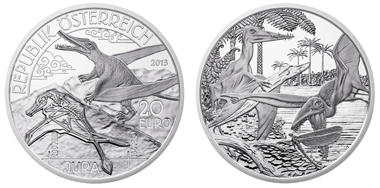September 5, 2013 – Continuing the adventure with dinosaurs and early life in the water, on land, and in the air, of middle western Europe from the Triassic to the Quaternary period, the Austrian Mint issues the second coin in the exciting series featuring Prehistoric Life and focuses on the Jurassic period now.
Austria / 20 EUR / silver .900 / 20.0 g / 34.0 mm / Design: Thomas Pesendorfer (obverse) and Helmut Andexlinger (reverse) / Mintage: 50,000.
The reverse of the coin features a dynamic scene of what life may have been like during the Jurassic period. A pair of large flying Rhamphorhynchus are depicted hunting a giant dragonfly at the water’s edge. The lush tropical vegetation climate is noted in the background ferns and palm tree-like cycads.
The obverse of the coin depicts the Rhamphorhynchus, with its long tail, broad wing span and needle-like teeth angled forward in its snout. The Rhamphorhynchus is creatively standing on the fossil of itself, which is on view today in the Natural History Museum in Vienna. Below the fossil on the coin is the time line which details the Jurassic period from 200 million years ago to 145 million years. This timeline is continuous from the first coin through to the fifth and final coin of this series.
Tremendous changes occurred at the beginning of the Jurassic period. Pangaea, the massive continent, broke up and the early beginnings of the North American and Eurasian occurred. Water flooded the huge valleys, oceans were formed, and mountains were forced up from the ocean floors. The hot dry air became warm and humid. A subtropical environment nourished the lush landscape. The warm and shallower inland seas gave way to a great variety of life. Reptiles made the greatest strides evolving from the water to the land and air because of their strong skeletons and intricate muscles. Their amniotic eggs were large and successfully supplied food and moisture to the young as they developed inside.
Photograph of a fossil cast of a Rhamphorhynchus skeleton exhibited in the North American Museum of Ancient Life, Lehi/Utah. Photo: Ninjatacoshell/ Dinoguy2 / http://creativecommons.org/licenses/by-sa/3.0/deed.en
The Rhamphorhynchus, was less than a foot long but had a wing span of three feet, tiny feet and a tail. It belonged to the pterosaur class, which were primitive flying reptiles with short bodies and large wing spans. Its wings were a thin membrane. Its long snout was ideal for catching fish and tearing it apart.
Fossils of the petrosaurs have been found in the UK, Germany, Austria, Spain and Portugal. Some of the fossils found are very complete and include the wing membrane, as well as even some of the internal organs.
Augmented Reality, A First from the Austrian Mint: a unique gateway to the fascinating world of prehistoric life, a free augmented reality App provides in-depth background information and brings the long-extinct creatures back to life in moving images.
Using a smartphone or tablet, open the Austrian Mint’s website and click on the link to download our free augmented reality App. The images found in the coin certificates, and collector packaging make this experience possible.
For checking out the first coin of the Prehistoric Life series, just click here.
If you want to know how a Rhamphorhynchus flying and catching fish from the sea might have looked like, please click here.
And if your kid is a fan of Rinkus from ‘The Land before Time’ but you always had trouble explaining the scientific background, just look here.






